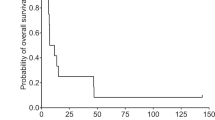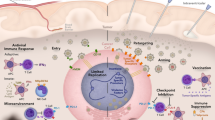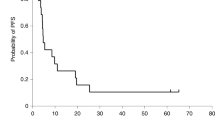Abstract
Malignant gliomas (MGs) are the most common malignant primary brain tumors with a short life estimate accompanied by a marked reduction in the quality of life. Herpes Simplex virus-1 thymidine kinase ganciclovir (HSV-TK/GCV) system is the best characterized enzyme prodrug therapy in use. However, lipophobicity of GCV and low enzymatic activity of HSV-TK reduce the treatment efficacy. Tomato TK (ToTK) has shown high activity in combination with its specific substrate azidothymidine (AZT). The aim of this study was to evaluate whether ToTK/AZT could be used as an alternative to HSV-TK/GCV therapy. Both treatments demonstrated cytotoxicity in human MG cells in vitro. In vivo, both treatments decreased tumor growth and tumors were smaller in comparison with controls in mouse orthotopic MG model. Survival of ToTK/AZT-treated mice was significantly increased compared with control mice (*P<0.05) but not as compared with HSV-TK/GCV-treated mice. No significant differences were observed in clinical chemistry safety analyses. We conclude that both treatments showed a beneficial treatment response in comparison to controls on tumor growth and ToTK/AZT also on survival. There were no significant differences between these treatments. Therefore ToTK/AZT could be considered as an alternative treatment option for MG because of its favorable therapeutic characteristics.
This is a preview of subscription content, access via your institution
Access options
Subscribe to this journal
Receive 12 print issues and online access
$259.00 per year
only $21.58 per issue
Buy this article
- Purchase on Springer Link
- Instant access to full article PDF
Prices may be subject to local taxes which are calculated during checkout




Similar content being viewed by others
References
Louis DN . Molecular pathology of malignant gliomas. Annu Rev Pathol 2006; 1: 97–117.
Omuro A, DeAngelis LM . Glioblastoma and other malignant gliomas: a clinical review. JAMA 2013; 310: 1842–1850.
Stupp R, Brada M, van den Bent MJ, Tonn JC, Pentheroudakis G . On behalf of the ESMO Guidelines Working Group. High-grade glioma: ESMO Clinical Practice Guidelines for diagnosis, treatment and follow-up. Ann Oncol 2014; 25: iii93–101.
Stupp R, Hegi ME, Mason WP, van den Bent MJ, Taphoorn MJ, Janzer RC et al. Effects of radiotherapy with concomitant and adjuvant temozolomide versus radiotherapy alone on survival in glioblastoma in a randomised phase III study: 5-year analysis of the EORTC-NCIC trial. Lancet Oncol 2009; 10: 459–466.
Lawler SE, Peruzzi PP, Chiocca EA . Genetic strategies for brain tumor therapy. Cancer Gene Ther 2006; 13: 225–233.
Maatta AM, Samaranayake H, Pikkarainen J, Wirth T, Yla-Herttuala S . Adenovirus mediated herpes simplex virus-thymidine kinase/ganciclovir gene therapy for resectable malignant glioma. Curr Gene Ther 2009; 9: 356–367.
Aghi M, Hochberg F, Breakefield XO . Prodrug activation enzymes in cancer gene therapy. J Gene Med 2000; 2: 148–164.
Portsmouth D, Hlavaty J, Renner M . Suicide genes for cancer therapy. Mol Aspects Med 2007; 28: 4–41.
Fillat C, Carrio M, Cascante A, Sangro B . Suicide gene therapy mediated by the Herpes Simplex virus thymidine kinase gene/Ganciclovir system: fifteen years of application. Curr Gene Ther 2003; 3: 13–26.
Moolten FL, Wells JM . Curability of tumors bearing herpes thymidine kinase genes transferred by retroviral vectors. J Natl Cancer Inst 1990; 82: 297–300.
Immonen A, Vapalahti M, Tyynela K, Hurskainen H, Sandmair A, Vanninen R et al. AdvHSV-tk gene therapy with intravenous ganciclovir improves survival in human malignant glioma: a randomised, controlled study. Mol Ther 2004; 10: 967–972.
Westphal M, Yla-Herttuala S, Martin J, Warnke P, Menei P, Eckland D et al. Adenovirus-mediated gene therapy with sitimagene ceradenovec followed by intravenous ganciclovir for patients with operable high-grade glioma (ASPECT): a randomised, open-label, phase 3 trial. Lancet Oncol 2013; 14: 823–833.
Khan Z, Knecht W, Willer M, Rozpedowska E, Kristoffersen P, Clausen AR et al. Plant thymidine kinase 1: a novel efficient suicide gene for malignant glioma therapy. Neuro Oncol 2010; 12: 549–558.
Mutahir Z, Larsen NB, Christiansen LS, Andersson KM, Rico R, Wisen SM et al. Characterization of oligomeric and kinetic properties of tomato thymidine kinase 1. Nucleosides Nucleotides Nucleic Acids 2011; 30: 1223–1226.
Larsen NB, Munch-Petersen B, Piskur J . Tomato thymidine kinase is subject to inefficient TTP feedback regulation. Nucleosides Nucleotides Nucleic Acids 2014; 33: 287–290.
Denny WA . Prodrugs for gene-directed enzyme-prodrug therapy (suicide gene therapy). J Biomed Biotechnol 2003; 2003: 48–70.
Danesi R, Falcone A, Conte PF, Del Tacca M . Pharmacokinetic optimisation of the treatment of cancer with high dose zidovudine. Clin Pharmacokinet 1998; 34: 173–180.
Laerum OD, Rajewsky MF, Schachner M, Stavrou D, Haglid KG, Haugen A . Phenotypic properties of neoplastic cell lines developed from fetal rat brain cells in culture after exposure to ethylnitrosourea in vivo. Z Krebsforsch Klin Onkol Cancer Res Clin Oncol 1977; 89: 273–295.
Hedman M, Hartikainen J, Syvanne M, Stjernvall J, Hedman A, Kivela A et al. Safety and feasibility of catheter-based local intracoronary vascular endothelial growth factor gene transfer in the prevention of postangioplasty and in-stent restenosis and in the treatment of chronic myocardial ischemia: phase II results of the Kuopio Angiogenesis Trial (KAT). Circulation 2003; 107: 2677–2683.
Munch-Petersen B, Cloos L, Tyrsted G, Eriksson S . Diverging substrate specificity of pure human thymidine kinases 1 and 2 against antiviral dideoxynucleosides. J Biol Chem 1991; 266: 9032–9038.
Munch-Petersen B, Piskur J, Sondergaard L . Four deoxynucleoside kinase activities from Drosophila melanogaster are contained within a single monomeric enzyme, a new multifunctional deoxynucleoside kinase. J Biol Chem 1998; 273: 3926–3931.
Dobrovolsky VN, McGarrity LJ, VonTungeln LS, Mittelstaedt RA, Morris SM, Beland FA et al. Micronucleated erythrocyte frequency in control and azidothymidine-treated Tk+/+, Tk+/- and Tk-/- mice. Mutat Res 2005; 570: 227–235.
Sato T, Neschadim A, Konrad M, Fowler DH, Lavie A, Medin JA . Engineered human tmpk/AZT as a novel enzyme/prodrug axis for suicide gene therapy. Mol Ther 2007; 15: 962–970.
Rich JN, Bigner DD . Development of novel targeted therapies in the treatment of malignant glioma. Nat Rev Drug Discov 2004; 3: 430–446.
Langford G, Dayan A, Yla-Herttuala S, Eckland D . A preclinical assessment of the safety and biodistribution of an adenoviral vector containing the herpes simplex virus thymidine kinase gene (Cerepro) after intracerebral administration. J Gene Med 2009; 11: 468–476.
Faulds D, Heel RC . Ganciclovir. A review of its antiviral activity, pharmacokinetic properties and therapeutic efficacy in cytomegalovirus infections. Drugs 1990; 39: 597–638.
Sandmair AM, Loimas S, Puranen P, Immonen A, Kossila M, Puranen M et al. Thymidine kinase gene therapy for human malignant glioma, using replication-deficient retroviruses or adenoviruses. Hum Gene Ther 2000; 11: 2197–2205.
Perez OD, Logg CR, Hiraoka K, Diago O, Burnett R, Inagaki A et al. Design and selection of Toca 511 for clinical use: modified retroviral replicating vector with improved stability and gene expression. Mol Ther 2012; 20: 1689–1698.
Chalmers D, Ferrand C, Apperley JF, Melo JV, Ebeling S, Newton I et al. Elimination of the truncated message from the herpes simplex virus thymidine kinase suicide gene. Mol Ther 2001; 4: 146–148.
Black ME, Kokoris MS, Sabo P . Herpes simplex virus-1 thymidine kinase mutants created by semi-random sequence mutagenesis improve prodrug-mediated tumor cell killing. Cancer Res 2001; 61: 3022–3026.
Preuss E, Muik A, Weber K, Otte J, von Laer D, Fehse B . Cancer suicide gene therapy with TK.007: superior killing efficiency and bystander effect. J Mol Med (Berl) 2011; 89: 1113–1124.
Sato T, Neschadim A, Lavie A, Yanagisawa T, Medin JA . The engineered thymidylate kinase (TMPK)/AZT enzyme-prodrug axis offers efficient bystander cell killing for suicide gene therapy of cancer. PLoS One 2013; 8: e78711.
Freeman SM, Abboud CN, Whartenby KA, Packman CH, Koeplin DS, Moolten FL et al. The "bystander effect": tumor regression when a fraction of the tumor mass is genetically modified. Cancer Res 1993; 53: 5274–5283.
Sandmair AM, Turunen M, Tyynela K, Loimas S, Vainio P, Vanninen R et al. Herpes simplex virus thymidine kinase gene therapy in experimental rat BT4C glioma model: effect of the percentage of thymidine kinase-positive glioma cells on treatment effect, survival time, and tissue reactions. Cancer Gene Ther 2000; 7: 413–421.
Stedt H, Samaranayake H, Pikkarainen J, Maatta AM, Alasaarela L, Airenne K et al. Improved therapeutic effect on malignant glioma with adenoviral suicide gene therapy combined with temozolomide. Gene Ther 2013; 20: 1165–1171.
World Health Organization, International Agency for Research on Cancer. IARC Monographs on the Evaluation of Carcinogenic Risks to Humans. Some Antiviral and Antineoplastic Drugs, and Other Pharmaceutical Agents 2000; 76: 73–127.
Lowenstein PR, Mandel RJ, Xiong WD, Kroeger K, Castro MG . Immune responses to adenovirus and adeno-associated vectors used for gene therapy of brain diseases: the role of immunological synapses in understanding the cell biology of neuroimmune interactions. Curr Gene Ther 2007; 7: 347–360.
Dewey RA, Morrissey G, Cowsill CM, Stone D, Bolognani F, Dodd NJ et al. Chronic brain inflammation and persistent herpes simplex virus 1 thymidine kinase expression in survivors of syngeneic glioma treated by adenovirus-mediated gene therapy: implications for clinical trials. Nat Med 1999; 5: 1256–1263.
Rainov NG, Kramm CM, Banning U, Riemann D, Holzhausen HJ, Heidecke V et al. Immune response induced by retrovirus-mediated HSV-tk/GCV pharmacogene therapy in patients with glioblastoma multiforme. Gene Ther 2000; 7: 1853–1858.
Acknowledgements
Authors thank Sari Järveläinen, Tiina Koponen, Riina Kylätie, Joonas Malinen, Anneli Miettinen and Mervi Nieminen for their skillful technical assistance. Dr Timo Liimatainen (A. I. Virtanen Institute for Molecular Sciences, University of Eastern Finland) is acknowledged for his assistance in MRI issues. The authors thank Professor Ari Hinkkanen’s research group (A. I. Virtanen Institute for Molecular Sciences, University of Eastern Finland) for providing GL261 and U87MG-Fluc cells and Ark Therapeutics Ltd for providing Ad.HSV-TK virus for the study. Support for the work: This study was supported by grants from ERC (#250050 Future Genes), Finnish Academy (CoE #141069), Sigrid Juselius Foundation and TEKES (#70043/10).
Author information
Authors and Affiliations
Corresponding author
Ethics declarations
Competing interests
The authors declare no conflict of interest.
Additional information
Supplementary Information accompanies the paper on Cancer Gene Therapy website
Rights and permissions
About this article
Cite this article
Stedt, H., Samaranayake, H., Kurkipuro, J. et al. Tomato thymidine kinase-based suicide gene therapy for malignant glioma—an alternative for Herpes Simplex virus-1 thymidine kinase. Cancer Gene Ther 22, 130–137 (2015). https://doi.org/10.1038/cgt.2014.76
Received:
Revised:
Accepted:
Published:
Issue Date:
DOI: https://doi.org/10.1038/cgt.2014.76
This article is cited by
-
The effect of gene therapy on postoperative recurrence of small hepatocellular carcinoma (less than 5cm)
Cancer Gene Therapy (2019)



